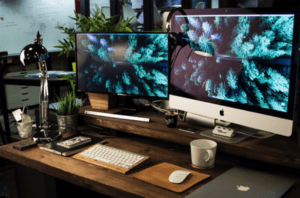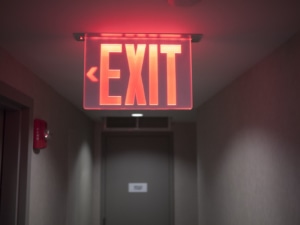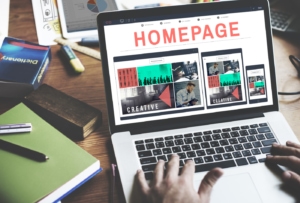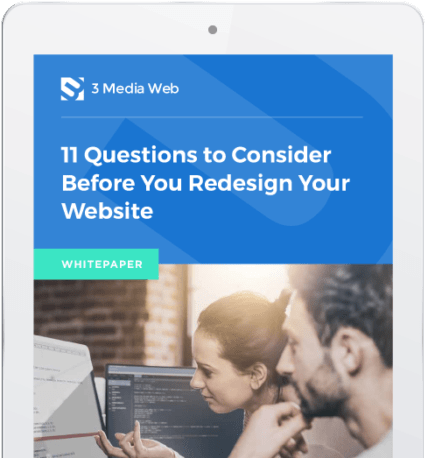Have you ever clicked on a website and found it difficult to navigate? Did the site have no photos, unclear photos or a busy color pattern? You may have left the site for a different one or looked to a competitor to meet your needs. Good visual elements of web design is important in building trust with the user. The use of visual elements is a key component in creating visually appealing websites, outstanding user experiences, and leads to engaged users and site conversion.
Several steps go into the use of visual elements in the web design process. The use of eye-catching imagery that supports your brand, use of color and intuitive user experience will create a great experience for your customers.
To assist you in the use of using visual elements in web design, we’ve compiled a one-stop-shop, complete with links to eight helpful sites, valuable excerpts, and our own commentary on what is effective and how to get the most out of your visual elements.
Need to update your company’s site with a fresh web design? Reach out to the team at 3 Media Web today to get started.
Let’s get started!

FURTHER READING: Picturing Success: 5 Things to Know About Visual Marketing
Per BusinessDaily, visual cues offer instant communication, which differs from reading web content or listening to a radio ad. Often the user isn’t even aware that an emotional reaction is happening.
According to Eric Lazar, the president of graphics and imaging company, Speedpro Loop, “Ninety percent of all purchases are made subconsciously, meaning they are driven by emotional processes, not intellectual ones. For the consumers that no longer have the time to educate themselves, it’s the logo or visual branding that will trigger the sale.”
Lazar also suggests testing what images evoke the emotional responses you are striving for your users to experience. “Like any other elements of your marketing, the visual elements of web design around your campaign need to be benchmarked and measured for key performance indicators. A/B testing is critical in visual marketing, allowing you to see which visual elements provoke the response you want. If you have the time and resources, test out options before you launch your campaign.”
Our Analysis
It takes 2.6 seconds for a viewer’s eye to land on the area of the homepage that will most influence their first impression. The images on your site are the first way users interact with your site and your brand.
The use of imagery that is eye-catching and memorable is key to sharing your message with the world. Imagery and branding elements are usually what people remember about your business. Consistent use of these visual elements of web design present your organization as trustworthy and memorable. Imagery in your marketing plan is too important to leave to chance, so A/B testing is a useful exercise in determining what resonates with your users.

FURTHER READING: 6 Web Design Mistakes (And How to Correct Them)
According to Nextweb’s Carrie Cousins, poor image choice on a site leads to poor user experience. ”The resolution is lacking, the focus is off or the tone just does not match your brand. Any of these image issues can be a website killer.” Carrie makes suggestions on how to obtain images for your site in her third item on the list.
Moving forward with poor images.
You used a bad image on your website. The resolution is lacking, the focus is off or the tone just does not match your brand. Any of these image issues can be a website killer.
The fix: A good website starts with a good image. If you are lacking quality images, there are a few options:
• Hire a photographer or illustrator to create an image deck
• Use stock images
• Create dominant “art” on your own using typography and color
Doing it right: There are tons of images and video on the Wild Renfrew site, and every single one is sharp, high-quality and engaging to look at. The images are what keep you scrolling down the page while begging for clicks. The site takes nice imagery another step too with a custom set of icons – that tie to the main logo – with a consistent look and feel to help you move through the design.
Our Analysis
High-quality imagery is key to telling your story.
The window is short for capturing your user’s attention and interest. Internet-goers spend an average of 5.96 seconds looking at your main image on the homepage. This short window of time gives you one opportunity to impress and engage your visitors through the use of imagery and video across the visual elements of web design.
Relatable and relevant images leave the user feeling the emotions you want to evoke and a clear understanding of how your organization fits in the marketplace. Low-quality images will leave the user unsure or even confused about who you are.
You may consider hiring a photographer to take photos of your staff and possibly customers. Images of your employees show the user that you’re a company made of real people who are serious about what you do. Photos of happy customers also lead to brand authority and trustworthiness.
Stock photos have their place in web design, but they should definitely be chosen carefully and truly represent your business mission and vision.
FURTHER READING: 7 Tips to Boost Web Conversion Rates Using Images
According to Steve Leher of Ringlead, “There are many people who buy for emotional reasons and so, the right approach would trigger an action. A positive image would bring up positive emotions, maybe smile, smirk or gesture. Pictures showing emotions often resonate with readers. A display of happy people tends to create an association of happiness as well. Keep in mind the emotions you want your visitors to feel as they view your site.”
According to Leher, “most of TV commercials use personalities or random people to demonstrate their products and hence, you need to analyze what is it that works? The conversion grows, when your website has pictures of happy customers. Posting these pictures of customers, along with their testimonies is believed to be a good strategy.”

Our Analysis
Your past customers and the positive interactions you’ve had with them is one of the most powerful tools you have. As such, you should use them to your advantage.
So, in addition to including glowing testimonials scattered throughout your website to build trust, including images of your customers as well is a great way to show people visually that others have interacted with your organization positively.
If a viewer sees real happy customers smiling about the product or service they received, that viewer is more likely to trust the testimonials they read and the services that you offer.
Be cautious about using stock photos. Seeing the same stock photos used on several sites does not typically build the trust you want. Photos of actual engaged customers and staff are sure to be uniquely yours and will work toward building loyalty and trust. Often photos are not difficult to obtain just by hiring a photographer for a few hours. These photos are well worth the investment.

FURTHER READING: 9 Must-Have Visual-Marketing Tools on the Web
According to an article by Entrepreneur, the following are a few suggestions for visual marketing tools.
“Not well versed in Photoshop? You can get the same effects using PicMonkey, a fantastic online picture-editing software. Edit the photo, touch up the image, add filters, add it to designs or create a collage. You have dozens of features at your fingertips. PicMonkey even has a huge collection of fonts to use, so you can do it all in one place….
“Shape collages are a great visual tool. With Loupe, you can show off hundreds of images that relate to your brand, campaign or event in a dynamic way. Imagine showing off the photos you took at a recent conference in an interactive heart that allows users to see everything by skimming over it. You can also make cards or an image-search game. All it takes is a bit of creativity to make this tool really work for you.”
Our Analysis
Photos that aren’t perfect can be altered for greater clarity or for different effects.

Photoshop is a robust platform with some amazing capabilities but does have a bit of a learning curve to master. If you don’t have the time or resources for Photoshop, you may consider PicMonkey and programs like it which are a bit easier to use and less expensive.
Perhaps you can use the same images in different ways, such as creating collages featuring company parties or a seminar that employees attended. With a bit of creativity, you may have the photos you need without hiring a photographer.
FURTHER READING: 9 Smart Widgets for a Better Customer Experience
Testimonials are a great feature to include and according to an article by Small Business Trends, you may have some options in this section of your site.
“Create a single or multiple review testimonial slider to put on your website with the aptly named Testimonial. It shows potential customers what people already love about your product or service. The simple format and elegant font make this slider appropriate for any layout.
“Choose between different layouts to make it even more flexible. Get their premium version for more control over how your testimonials are viewed….
“The best way to improve your site for customers is to find out what it is they want or need from you. WordPress Feedback Form is a quick way to do that and to start gathering valuable information you can use for future changes. This is the ultimate feedback form, and probably the most popular.
“You just fill in the blanks and choose your layout, and present it in the most attractive manner that matches your web design.”
Our Analysis
 Testimonials are a great feature to showcase on your site. Testimonials lend credibility and build trust with your visitors.
Testimonials are a great feature to showcase on your site. Testimonials lend credibility and build trust with your visitors.
To get the most out of your testimonials, you should seamlessly incorporate them into your website throughout the pages, and one of the best ways to do that is with a testimonial slider.
Depending upon the theme or framework of the site that is chosen, you may wish to list testimonials strategically as your visitors scroll through your site.
Consider adding a WordPress Feedback Form: It’s always important to be trying to improve your website. What better way to do that than by asking the viewers for their feedback directly?
According to an article by a well-known marketer, Neil Patel, color scheme choices are more important than you may think.
“Just like it’s crucial to choose the right color for your brand logo, it’s equally as crucial to choose the right color scheme for your website.
“You don’t want to pick your color scheme at random or base it on “whatever looks cool” to you…
 “Consider your overall demographic”
“Consider your overall demographic”
“Consider the personality and emotions of your target audience. Then choose the best color to serve as the primary color for your website color scheme.
“Here’s a mistake that I’ve seen many businesses make when choosing a color scheme. And that’s basing it on their personal preferences rather than psychology.”
“If your favorite color is blue, it’s very tempting to make blue your primary color.
“But if you’re a cosmetics company targeting a female demographic, this would be a mistake, and you would usually be better off going with purple or pink.”
Our Analysis
Color is vastly important when choosing what hues are going to be representing your brand and there is tons of research out there looking at what colors are associated with “what” and are best for targeting “who”.
In making color choices for your site, it’s often suggested to really review some of the psychology behind color associations and decide what colors truly best represent you and your brand.
Calls to action are usually placed as buttons or links on your homepage. After learning about your organization, the goal is typically to steer your user to click this call to action to purchase or learn more about your products or services. Practical Ecommerce references the following call to action plugins as suggestions.
 “Easy Social Share Buttons allows you to share on more than 35 major social networks. It includes 18 automated display buttons, 7 shortcodes, 22 templates, and 12 native-like, follow, and subscribe buttons. The social sharing plugin comes with 8 premium modules, including after share actions and social share analytics….
“Easy Social Share Buttons allows you to share on more than 35 major social networks. It includes 18 automated display buttons, 7 shortcodes, 22 templates, and 12 native-like, follow, and subscribe buttons. The social sharing plugin comes with 8 premium modules, including after share actions and social share analytics….
“Exit Intent provides a simple way to convert more visitors to buyers and build your email subscription list. Messages show up with a special offer at the moment a visitor is about to leave your site. Get a second chance to convince your visitors.”
Our Analysis
Easy Social Share Buttons: The days of scouring the yellow pages and newspaper ads and checking out the bulletin board downtown are over. Social media is the new phonebook.
Social media is easy to navigate and as a viewer and has a much broader reach than an ad in your local newspaper.
The downside? There are a lot of highly-used social networks out there, and navigating them from behind the scenes is a little trickier than it was in the days of the phonebook.
This Easy Social Share app now allows you to connect on over 50 major social networks, and it makes it easier for you to keep track of your reach with a built-in follower count.
 Exit Intent: Conversions on exit are often based on intent.
Exit Intent: Conversions on exit are often based on intent.
If you add in an exit popup add for every viewer that comes onto your site and can’t find what they’re looking for, you’re not going to see that increase in conversion that you’re looking for.
Additionally, despite the many studies that will claim a high increase in conversion rates, the reality is that you’re probably only going to see about a 5-10% increase and only if you use an effective strategy.
An example of a more effective strategy may be to implement a popup ad offering a free download or a discount if the viewer has been poking around your website, reading articles or exploring products.
However, it is also possible that the effectiveness of exit-intent popup ads is on a downslide, so you may want to keep an eye on the statistics and do some research to decide if this is something you’re interested in putting time into.
FURTHER READING: 27 Research-Backed Web Design Tips: How to Design a Website That Works
The following are some tips from the Orbit Media.
“The headline on the top of the homepage (and every page) is either descriptive or not. If not, the visitor may not be able to answer their first question: “Am I in the right place?”
“It’s also an opportunity to use a target keyphrase and indicate relevance. But a lot of search marketers write something clever or vague instead. But clear is better than clever…
“Don’t put all of your calls to action at the top. Visitors may be spending more time there, but that doesn’t mean that they’re ready to take action. A lot of persuasion happens farther down the page.”
Our Analysis
It’s important to understand the goals of your homepage. You want people to connect with your business through the use of images.
 A clever and clear headline is the goal for your site. Even finding the balance between the two will work if you are clear enough to pique their interest and clever enough that they want to see more.
A clever and clear headline is the goal for your site. Even finding the balance between the two will work if you are clear enough to pique their interest and clever enough that they want to see more.
But if you have a witty headline and the viewer can’t find a clear indication of what your website is for, then they move onto websites that are clear and easier to navigate.
When thinking about calls to action, you may consider a fishing metaphor The second you feel a tug on the line, if you pull too hard, you may just lose the fish. They aren’t yours until you’ve reeled them all the way in and lifted them onto your boat.
It’s usually best to ensure your viewers are well acquainted with your brand and your products or services before you bombard them with calls-to-action.
Visual Elements of Web Design Best Practices
A lot of thought and research may go into choosing the right color palette, image choices and other visual elements of your site. However, a well-planned, cohesive site that best represents you and your business will be worth the effort.
Good luck!

